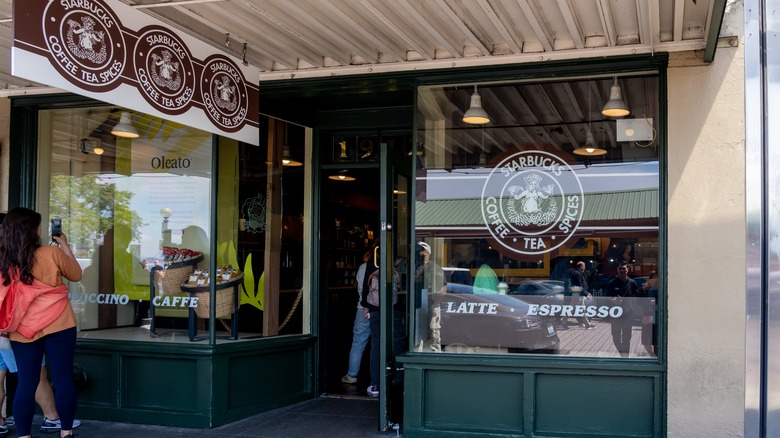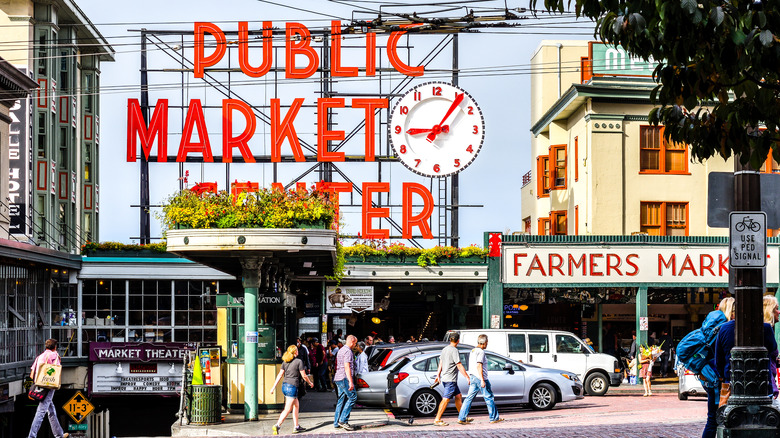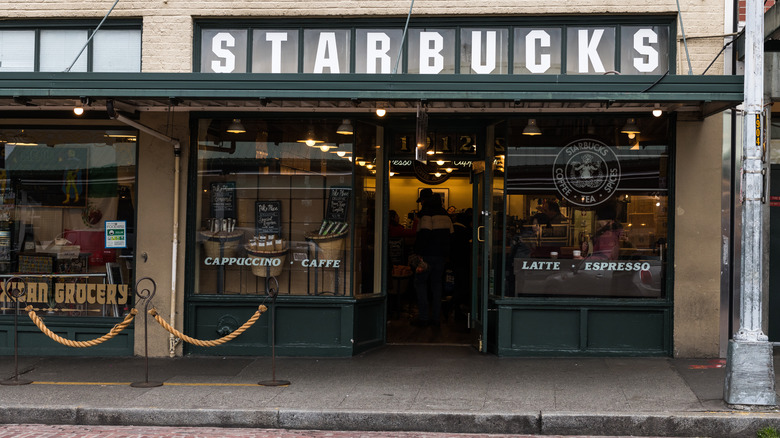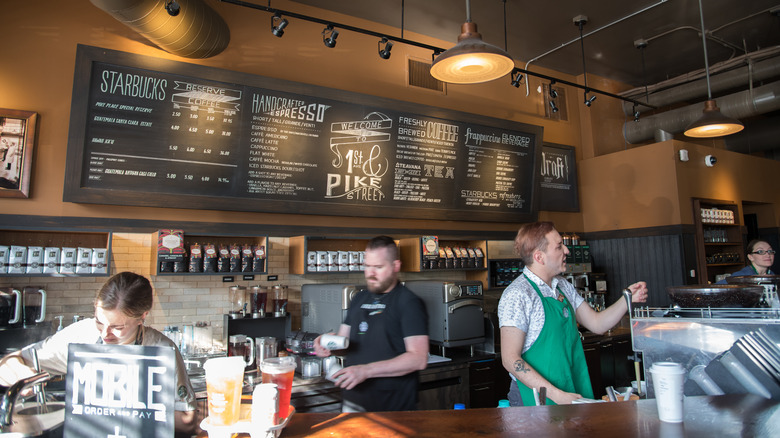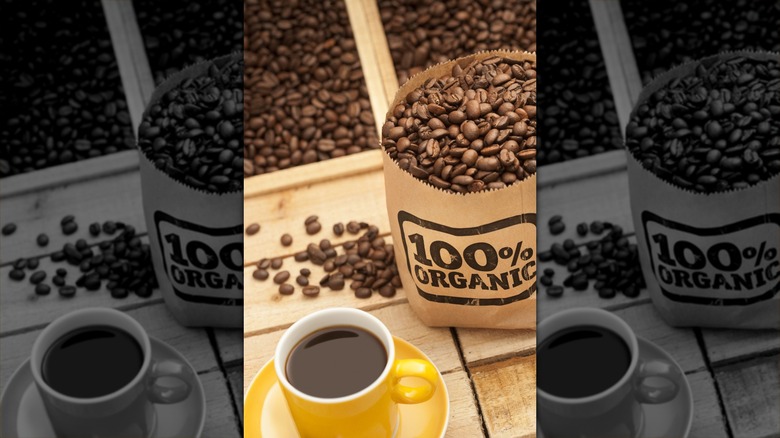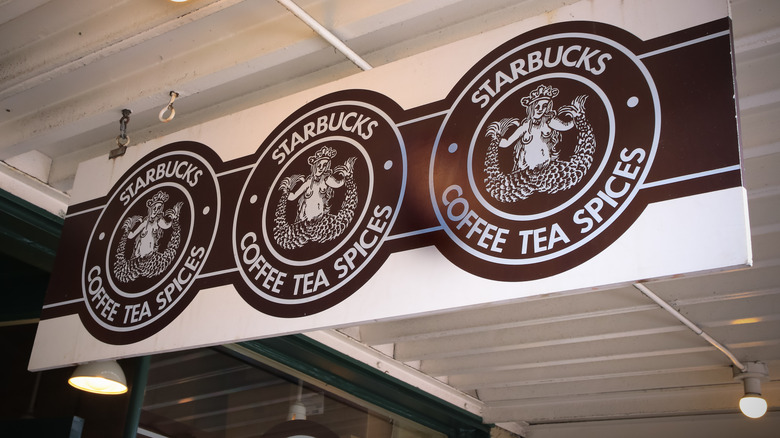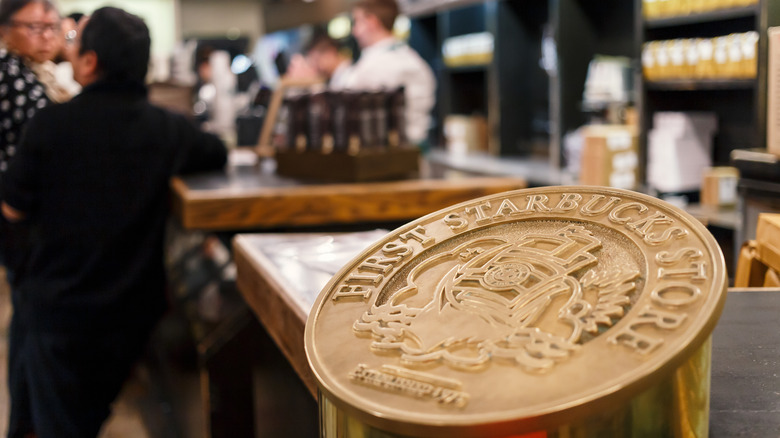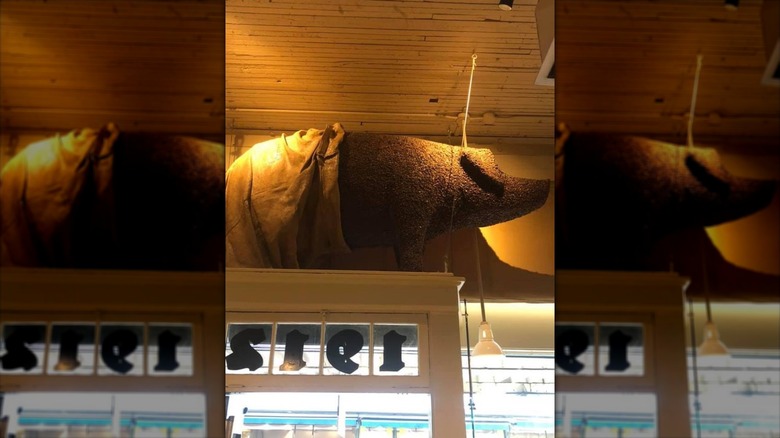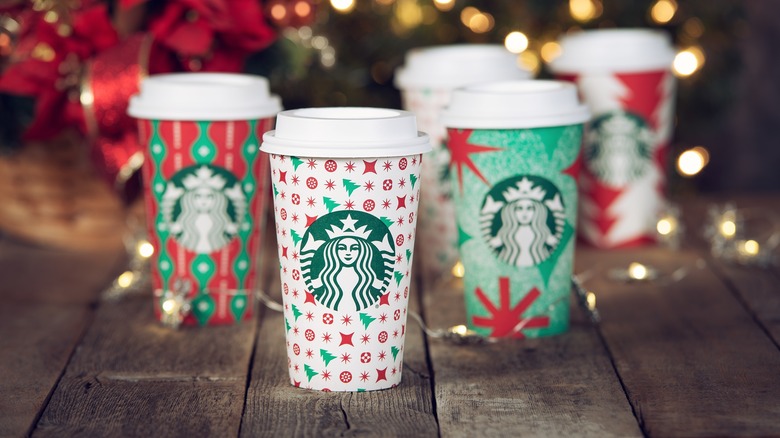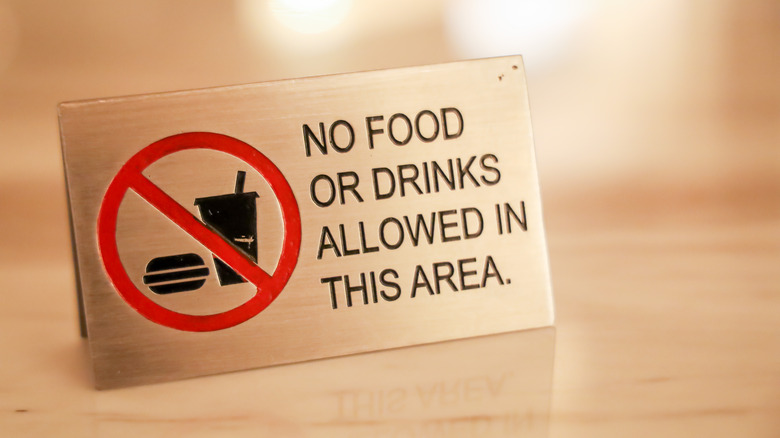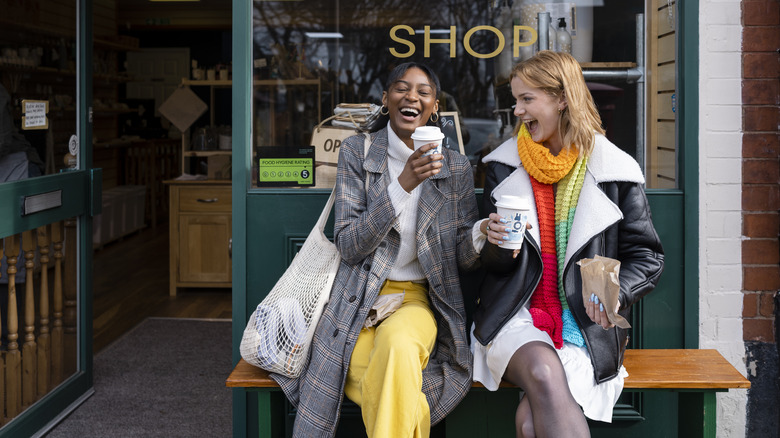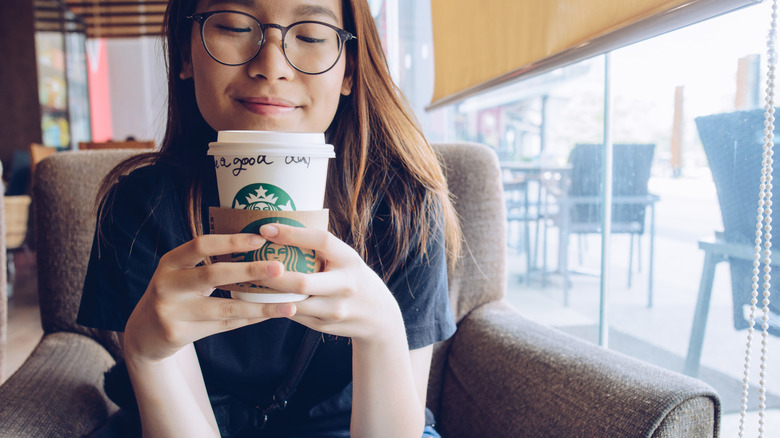What It Was Like To Go To The First Starbucks
Once upon a time, the coffee culture experience meant watching the top of a percolator coffeepot spit brown liquid into a little glass knob on the pot's lid. Once the coffee stopped burping into the little glass knob, the coffee was done. High taste, it wasn't. Unlike nowadays, where people wait for months for Starbucks' pumpkin spice latte season to start, no such frou-frou drinks existed. No, pre-1970s coffee tasted as watery as it looked. In those pre-French-roast-in-a-bag days, if you wanted extra strong coffee, you added more Folgers to the pot and crossed your fingers that you'd get a decent cup.
Although few knew it then, coffee's second wave waited in the wings, ready to pounce on the unsuspecting coffee consumer, and of course, Starbucks did actually have something to do with advancing coffee's second wave. During Starbucks' early days – first at its original address at 2000 Western Avenue, Seattle, and then eventually a couple of blocks over at 1912 Pike Place — no pumpkin spice lattes existed yet. What did exist were the raw materials for the best cup of home-brewed coffee in town — quality coffee beans from faraway places. It didn't hurt that the original Starbucks nabbed a convenient spot in the thick of the activity at the Pike Place Market. Newly minted gourmet coffee fans were lured into the shop by the promise of free samples. In short, the original Starbucks looked almost nothing like Starbucks does today. Here's the scoop.
The character of the waterfront influences its vibe
If you were to make your way down to Pier 55 in the early '70s when the first Starbucks came into being, you'd be forgiven for thinking that maybe you veered off into a fish market instead. While we exaggerate a bit, given the rich coffee smell that permeates all Starbucks stores, this comparison isn't too far off the mark. From its beginning, the waterfront at Pike Place Market and the sea infused the burgeoning coffee shop with much of its character. Baristas tossed cups to one another in the same fashion that the fishmongers in the market tossed fish to each other. The name came from the sea as well. The character Starbuck in "Moby Dick" gave the seaside coffee shop its name. The myth of the sea sirens inspired the chain's logo. The interior evokes the interior of ships at sea.
Of course, it would have been difficult for Starbucks' original customers to not be aware of the waterfront once inside the shop. The view from the front window looks out on the streets of Pier 55. And as anyone who's ever been to Seattle's public market can tell you, it's impossible not to smell the nearby waters of Puget Sound or hear the boat horns blaring and seabirds calling. To call the original Starbucks at 1912 Pike Place a gift from the sea is no exaggeration.
The original Starbucks is only about 1,000 square feet
At 35,000 feet, the world's largest Starbucks (in Chicago) is about 35 times larger than the original Starbucks. Its food counter is a wonder to behold, with a variety of artisan breads, fruit salads, and other delights beckoning the hungry and un-hungry alike. A long bar and barstool after barstool invite visitors to sit a spell. By comparison, the first Starbucks was and still is only around 1,000 square feet. From the street, it looked like a small urban bodega where you might pick up some milk on your way home from work. Inside, customers perused a shelf of goodies on one side of the store before paying for their wares on the other side of the store. Maybe about 10 or 15 feet, max, stood between the two sides of the store.
Stepping inside it today is as close as you can get to taking a ride in a time machine. Every original fixture, the counter, the hardwood floors – those are all original, right down to the coat hook that workers installed for an early regular who wanted a place to hang her coat while she shopped. Tables and chairs were conspicuously absent. People didn't linger over a hot cup of Joe like they do today. Few who shopped in that early store would have ever imagined that their favorite corner roasted coffee beanery would eventually spawn not only the 35,000-foot mega-Bucks but a worldwide chain of coffee houses.
The espresso bar stood above people's line of sight
Nowadays, we think nothing of going out to coffee as being a bit akin to spending an evening at the theater. With the whizzing whirl of the espresso machines and the lively banter of baristas chatting with customers and one another, all against a backdrop of the tunes du jour on Starbucks radio, it's as entertaining as anything you'll see at a puppet show or perhaps, a circus. This was by design, starting with the first Starbucks, which featured an elevated espresso bar. This allowed customers to watch their favorite baristas while they made their drinks. Given that the baristas tossed cups to one another on the regular in the original store, it's likely that they put on quite a show, indeed.
The original store still has no place to sit, but even today, in the 21st century, people wait in long lines to experience Starbucks Numero Uno. Some of this surely has to do with the nostalgia of it all, but some of it is likely for the theatrical view that the elevated espresso bar provides. In the mid-2000s, when Starbucks struggled with closures, the powers that be acknowledged that the adoption of espresso machines that were quick and easy instead of theatrical and the replacement of the "neighborhood store" vibe with something more expedient ruined the once-elevated experience, per The Guardian. Fortunately, those who visit the original store today can still catch the show.
Bespoke roasted coffee was hand scooped into bags
When Jerry Baldwin, Gordon Bowker, and Zev Siegl first introduced the concept of bespoke roasted coffee beans, coffee culture as we know it today didn't exist. When people drank coffee at home in the early 1970s, it was decidedly weak and about as far from the gourmet experience as you can get. Few people sought out coffee from places like Costa Rica, Mexico, and Ethiopia. At first, Starbucks went with coffee beans roasted by Peet's Coffee – out of Berkeley, California – before the founders and their crew began roasting their own coffee beans. Early Starbucks employees filled paper bags with their bespoke, hand-scooped coffee beans instead of paper cups filled with Starbucks seasonal specialty drinks. It would take Howard Schultz buying out Starbucks in 1987 before the chain began producing its now-famous drinks.
The emphasis on freshly roasted coffee beans played such an integral role in the early Starbucks brand that if beans had sat in the store for more than a week, Starbucks employees donated those beans to charity. Such strict attention to quality and brand is likely why Starbucks has built the brand following it has today. Generally speaking, nowadays, the average Starbucks patron visits his or her store of choice about 18 times a month. The attention to brand and bean is probably also why there is a 300-foot line stretching around the original Starbucks during store hours, even today.
The original double-tailed siren greeted the customers
The original owners of Starbucks wanted their coffee shop to have the power to lure people in, and while the promise of free coffee samples certainly didn't hurt the store's draw, owners Baldwin, Bowker, and Siegl wanted something a little more tangible and alluring to represent the company: the siren. Mythical sirens lured seamen out to sea, often to their deaths, and the Starbucks' owners wanted their place to be as alluring as a siren at sea. It became the store's logo and mascot, and like its mythological counterpart, it had features that made it alluring. Choosing the siren allowed the company to align with its waterfront nautical-inspired vibe.
The modern Starbucks logo is green instead of brown and not so anatomically, shall we say, intriguing as the original brown Starbucks logo was. In total, the Starbucks logo has undergone three design overhauls. Green replaced brown as the logo color when Il Giornale and Howard Schultz bought out Starbucks in 1987. In 2011, another iteration of the logo appeared. It lacked the company name and product line, allowing the company to expand the brand beyond coffee and tea and to take it worldwide. For Starbucks tourists who make the pilgrimage to the original store, the sight of the brown logo offers a glimpse at how much the trappings of the chain have changed over the years.
The inside of the first store replicates the interior of a ship
If you've ever been fortunate enough to tour the inside of an old tall ship, you'd likely be struck by visions of hardwood everywhere. Kitchen galleys, staterooms, and the lower decks were all decked out in the most available building materials of the day. This consisted of wood, wood, and more wood, judging from the photos of restored ships or even the wrecks that occasionally show their bones when the tide goes out. We offer you this short history lesson to point out the rationale behind the design of the original Starbucks. It's wood, wood, and more wood from floor to ceiling because the original owners hoped that the store would remind visitors of the ships that brought spices to the masses. Although most spice shoppers today don't go to the local Starbucks to buy spices to fill their spice racks, Starbucks shoppers in the early 70s had that option. Of course, they also stopped by the store to buy tea and coffee, but originally, spice showed up on the product lists, too.
This, of course, echoes all of the other nautical-theme accouterments that greeted the original Starbucks visitors in the 1970s. It's likely that the inside of the coffee store would have looked like many of the other shops down at the Pike Place Market. Starbucks, along with its neighbors, offered passersby the sights and scents of those tall ships that floated by in the harbor.
Pork-N-Beans, a coffee-bean-covered pig, holds court near the ceiling
As a customer of the original Starbucks, it would have been difficult to miss the tongue-in-cheek humor that permeated the atmosphere of the store. Between needing to duck to avoid being hit by tossed cups to wondering if the company's logo was NC-17 or not, good humor bubbled over the proverbial coffee pot. However, early store visitors might have had to look a bit to see one of the biggest displays of humor in the store because it isn't exactly at eye level.
We are speaking about Pork-N-Beans, the coffee bean-covered pig that has stood guard over the door of the original Starbucks since 2001. Although not a part of the 1970s decor — he was acquired much later in the store's history — this coffee bean-covered pig was acquired in the way all good pigs are acquired: By winning an auction. The good cause in question was the Pike Place Market Foundation. It is probably fair to say that if customers missed him on the way into the store, it's unlikely that they missed this mascot on the way out of the store since he's over the front door. True Starbucks aficionados might balk at the pig being called an original fixture of the store. However, it could be argued that the store technically isn't original either. Like the pig mascot, it was acquired later, making the store and the pig part of the original Starbucks lore.
The original store didn't serve the kind of coffee drinks we know today
In the 2000s, it's hard to imagine the fall and winter seasons without ads extolling the virtues of pumpkin-flavored drinks or those red and green cups around Christmastime. For many coffee lovers, a change in coffee recipes at Starbucks is the first indication that the seasons themselves are about to change. Indeed, the drink menu for the company has come a long way since the chain's early days at 1912 Pike Place, where early customers could only get bags of roasted coffee beans, as well as tea and spice samplings. When hot coffee finally did become a thing in what is now the first-ever Starbucks store, its purpose was to provide samples for early customers. What better way to entice people to buy those gourmet beans, which in that era was a fairly new concept, than to offer people a few swigs of the roast of the day?
Nowadays, we look at frou-frou coffee through chocolate-covered whipped cream lenses, not really appreciating how novel fresh-roasted coffee beans were in the early 1970s. Early Starbucks customers felt content to watch their favorite novelty beans percolate in their home coffee pots. It wasn't until eventual Starbucks CEO Howard Schultz got introduced to foamy-topped coffee drinks that Starbucks became known as the dessert coffee extraordinaire that it is today.
The original lease prohibited food sales
If those hangry feelings struck original Starbucks customers at 3:00 p.m., their favorite coffee shop couldn't satisfy their hunger. For that, they needed to find someplace else to get a late afternoon snack instead of at Starbucks. Back then, people only went into 1912 Pike Place to pick up their favorite bespoke coffee beans in brown paper bags, as well as bulk spices and teas. The reason was simple. The original lease didn't allow for the sale of food at Starbucks. It's difficult to fathom now, particularly for those of us whose thoughts land on Starbucks as a viable option for lunch out with friends. But the original Starbucks carried no Impossible sausage biscuits for breakfast, snacky cake pops, or even slices of banana bread. Customers in the 1970s went into the shop to get their gourmet coffee fix satisfied, and that's it.
Things haven't changed much in the ensuing years, at least not at that Starbucks location. People taking a pilgrimage to Starbucks 1.0 will find plenty of coffee drinks, including the frou-frou flavored kind with copious amounts of whipped cream and chocolate, as well as burlap seed bags, which are leftovers from the former tenant, a seed company. Pilgrimaging customers also, of course, find lots of souvenirs, like Starbucks mugs, hats, and T-shirts. What they won't find is food nor a table to eat it at. For that, they'll have to stop in at one of the many waterfront eateries to get their nosh on.
The original Starbucks was part of the second wave of coffee culture
Going out to coffee with friends as a form of entertainment didn't quite enjoy the kind of popularity that such activities do here in the 21st century. While the coffee shop diner did exist in the 1970s, eating someplace besides home still had that "special treat" kind of vibe until the second wave of coffee consumption hit consumers right in their taste buds. Before the second wave, coffee drinkers just felt happy that they had a little joy juice to kickstart their day. Once the second wave hit its stride, coffee drinkers figured out that drinking coffee was so much more pleasurable if it tasted good.
Starbucks positioned itself to ride coffee's second wave. To secure their gourmet roasted beans, the three Starbucks owners – Zev Siegl, in particular – tapped Alfred Peet of Peet's coffee. Peet not only helped the three secure gourmet beans, but he eventually taught Jerry Baldwin how to roast coffee. This allowed him to bow out of his advisory and supplier role to Starbucks, eventually encouraging its independence. Roasting its own coffee took Starbucks from coffee seller to favored third space in a very short time. For those unfamiliar with the concept of the third space, it's a place where people hang out that's not work nor home but a familiar and comfortable third space – hence, the name – that gives them a place to socialize and drink good coffee somewhere off the normal beaten path.
Brewed coffee drinks weren't really its thing
In a time where you can order a double frappuccino latte with triple milk and a cookie on top from your mobile phone and then head on over to your local Starbucks to pick it up, it seems a tad strange to go into Starbucks and not pick up a nice cup o' Joe while there. But during its early days, brewed coffee drinks didn't draw customers in. It was the promise of a few scoops of gourmet coffee beans poured into paper bags, ready for home consumption, that drew them in.
While it's true that Starbucks eventually started brewing coffee in store, store workers didn't brew the coffee to sell it. Rather, it provided samples for would-be customers who were sitting on the fence and who needed a bit of a nudge to hop off said fence and order something. Early customers showed more willingness to buy the coffee when they could taste it first. It wasn't really until eventual CEO Howard Schultz took his fateful trip to a trade show in Milan and truly tasted what steamed milk and coffee properly brewed together could do for the coffee business. Even then, he couldn't convince the original three owners to implement the kind of barista service we've become used to today. He had to buy the company out to fully realize his dream and to turn Starbucks into the global coffee experience it has become.
